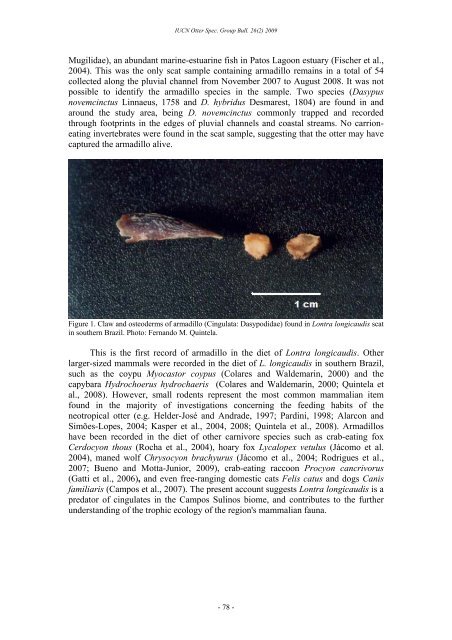Pages (PDF 3 MB) - Otter Specialist Group
Pages (PDF 3 MB) - Otter Specialist Group
Pages (PDF 3 MB) - Otter Specialist Group
You also want an ePaper? Increase the reach of your titles
YUMPU automatically turns print PDFs into web optimized ePapers that Google loves.
IUCN <strong>Otter</strong> Spec. <strong>Group</strong> Bull. 26(2) 2009<br />
Mugilidae), an abundant marine-estuarine fish in Patos Lagoon estuary (Fischer et al.,<br />
2004). This was the only scat sample containing armadillo remains in a total of 54<br />
collected along the pluvial channel from November 2007 to August 2008. It was not<br />
possible to identify the armadillo species in the sample. Two species (Dasypus<br />
novemcinctus Linnaeus, 1758 and D. hybridus Desmarest, 1804) are found in and<br />
around the study area, being D. novemcinctus commonly trapped and recorded<br />
through footprints in the edges of pluvial channels and coastal streams. No carrioneating<br />
invertebrates were found in the scat sample, suggesting that the otter may have<br />
captured the armadillo alive.<br />
Figure 1. Claw and osteoderms of armadillo (Cingulata: Dasypodidae) found in Lontra longicaudis scat<br />
in southern Brazil. Photo: Fernando M. Quintela.<br />
This is the first record of armadillo in the diet of Lontra longicaudis. Other<br />
larger-sized mammals were recorded in the diet of L. longicaudis in southern Brazil,<br />
such as the coypu Myocastor coypus (Colares and Waldemarin, 2000) and the<br />
capybara Hydrochoerus hydrochaeris (Colares and Waldemarin, 2000; Quintela et<br />
al., 2008). However, small rodents represent the most common mammalian item<br />
found in the majority of investigations concerning the feeding habits of the<br />
neotropical otter (e.g. Helder-José and Andrade, 1997; Pardini, 1998; Alarcon and<br />
Simões-Lopes, 2004; Kasper et al., 2004, 2008; Quintela et al., 2008). Armadillos<br />
have been recorded in the diet of other carnivore species such as crab-eating fox<br />
Cerdocyon thous (Rocha et al., 2004), hoary fox Lycalopex vetulus (Jácomo et al.<br />
2004), maned wolf Chrysocyon brachyurus (Jácomo et al., 2004; Rodrigues et al.,<br />
2007; Bueno and Motta-Junior, 2009), crab-eating raccoon Procyon cancrivorus<br />
(Gatti et al., 2006), and even free-ranging domestic cats Felis catus and dogs Canis<br />
familiaris (Campos et al., 2007). The present account suggests Lontra longicaudis is a<br />
predator of cingulates in the Campos Sulinos biome, and contributes to the further<br />
understanding of the trophic ecology of the region's mammalian fauna.<br />
- 78 -
















